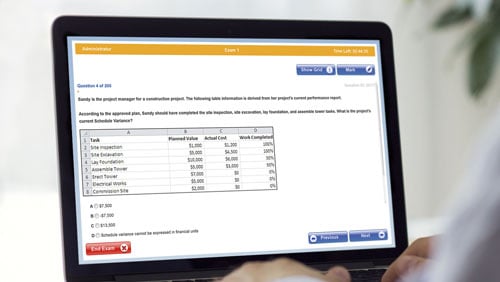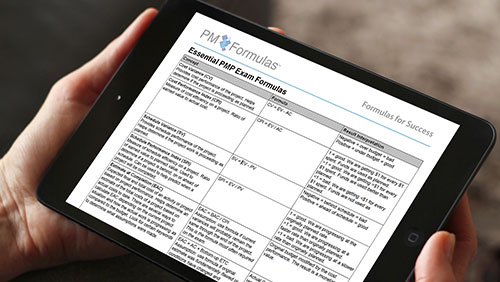Predictive, Waterfall… Now “Linear”: What Every PMP Candidate Must Know
Ashley finished her last practice test feeling confident about predictive vs. adaptive life cycles, only to stare blankly when the real exam asked about Linear Project Management. If you do not want the same surprise, read on. By the end of this guide you will know exactly what linear means, where it fits in the life-cycle family, how to spot it during your real PMP exam, and how to pick the right answer in our sample question.
Why the term matters right now
Recent feedback from test takers shows that PMI has begun substituting the adjective linear for the terms predictive or waterfall. The intent is not to introduce a new methodology. It is to see whether you can map fresh vocabulary to concepts you already know.
This article is not a definitive treatise on Linear Project Management. Instead, it gives PMP candidates the key points they need if the term appears on the exam.
Let's continue with a definition that I created based on the research for this article:
linear project management
noun
A method of managing projects characterized by a sequential progression through distinct phases, with each phase largely completed before the next begins. Emphasizes detailed upfront planning, extensive documentation, and a relatively fixed scope. Often referred to as the waterfall method.
The definition is by no means perfect, but allows us to summarize this core idea: one pass, one direction, no overlap, with little change once the train has left the station.
Where linear fits in the life-cycle family
Below is a text-based Work Breakdown Structure (WBS) with various life-cycles. Reading it top to bottom shows the big buckets first, then examples inside each bucket. This Work Breakdown Structure shows the home of linear models at 1.1.1:
1 Project Life-Cycle Families
1.1 Predictive (Plan-Driven)
1.1.1 Linear Models
1.1.1.1 Waterfall
1.1.1.2 V-Model
1.1.1.3 Stage-Gate
1.2 Incremental
1.2.1 Incremental Build (scope fixed, delivery in chunks)
1.3 Iterative
1.3.1 Spiral
1.3.2 Rational Unified Process
1.4 Adaptive / Change-Driven
1.4.1 Iterative-Incremental-Adaptive
1.4.1.1 Scrum
1.4.1.2 Kanban
1.4.1.3 Extreme Programming
1.5 Hybrid
1.5.1 Predictive Front End with Adaptive Delivery
1.5.2 Rolling Wave Planning
How to recognize linear on exam day
If, during your real exam, the following cue words show up in the question or answer options, then you may be looking at linear project management:
- Complete scope or requirements known at project start
- Sequential one-pass flow through phases
- Each phase must finish before the next can begin
- Formal change request process and changes are costly
- Heavy baseline documents and phase sign-offs
- Phase-gate or stage-gate reviews
- Milestones are fixed and provide tight schedule control
- Customer feedback typically collected at end of phase/project after deliverables are completed
- Best for stable environments such as construction or regulated hardware
Strengths and trade-offs
| Advantage (often in “select two” items) | Limitation or risk |
|---|---|
| High cost and schedule predictability once baselines are set | Difficult to accommodate emerging requirements |
| Clear milestones simplify status reporting and governance | Feedback and defect discovery come late, rework can be expensive |
| Supports contract, compliance, and safety reviews | Idle resources if one phase slips while downstream teams wait |
Analogy: Symphony Score vs. Jazz Improv
Picture two concert halls on opposite sides of town.
The symphony performance: Linear in action
The orchestra files onto stage, each musician with the same printed score. The conductor raises the baton, and the piece unfolds exactly as the composer wrote it years ago. Movements follow one another in a fixed order: Allegro, Adagio, Scherzo, Finale. If the oboist misses a cue the entire section stops, resets, and re-enters together. Every lighting cue, page turn, and tempo change was planned at rehearsal.
- Complete scope locked early: the entire score is approved before the first audience arrives.
- Sequential flow: movement 2 cannot begin until movement 1 has resolved.
- Formal change control: altering a key or tempo would require re-orchestrating the parts and re-printing the scores.
- Heavy documentation: every note, dynamic, and rest is captured in writing.
This is Linear Project Management. Phase-gate reviews map to rehearsal sign-offs. The music analogy highlights fixed scope, high predictability, and the cost of late change.
The jazz club next door: Adaptive at work
Across town the trio takes the stage with only a lead sheet containing the bare melody and chord progression. The pianist sets the groove, the bassist experiments with a counter-line, and the drummer adjusts dynamics based on the crowd’s energy. After each chorus they trade solos, listen, and adapt. If the audience leans in when the pianist adds a blues phrase, the group extends that idea in the next round.
- Emergent scope: details evolve as the players hear one another.
- Short iterations: every chorus is a mini-sprint delivering audible value.
- Continuous feedback: audience reaction and band interplay steer the next measure.
- Low documentation: a few chords on napkin paper are enough to start creating.
This mirrors Adaptive or Agile life cycles, where quick increments, team inspection, and customer feedback shape the final solution.
Why the analogy helps on the PMP exam
| Aspect | Symphony / Linear | Jazz / Adaptive |
|---|---|---|
| Scope | Fully scored before showtime | Evolves during performance |
| Sequence | Movements in fixed order | Sections repeat or pivot on demand |
| Change handling | Costly, formal, disrupts entire orchestra | Built-in, quick, encourages innovation |
| Documentation | Every note written | Minimal lead sheet |
When you read a scenario with locked specifications, formal approvals, and high predictability, think symphony score: that answer choice belongs to the predictive family. When the question mentions evolving requirements, short cycles, and frequent stakeholder input, recall jazz improv: select the adaptive option.
Put it to the test: PMP exam sample question about linear project management
Scenario
You are managing the build-out of a regional data center. The facility must meet strict regulatory requirements before any customer equipment can be installed. Complete electrical, mechanical, and fire-suppression designs have been approved and baselined. Midway through excavation the local municipality mandates an unplanned archaeological survey on one quadrant of the site, which may delay progress by three weeks. The project sponsor asks which life-cycle approach and schedule action will best protect the target completion date.
Which option should you recommend?
- Switch to an adaptive life cycle and deliver the facility in two-week sprints while the survey proceeds.
- Keep the linear life cycle, fast-track construction activities that are not affected by the survey, and update the schedule.
- Move to an incremental build model that completes unaffected quadrants first, deferring the design close-out for the surveyed area.
- Retain the linear life cycle, add management reserve equal to the three-week delay, and issue a change request to shift the baseline dates.
Correct answer: B
Explanation: The project was established under a fully defined, regulated scope. That is a textbook predictive environment, so switching life-cycle families would introduce unnecessary contract revisions. Fast-tracking independent work within the same linear model compresses time without altering scope or governance. Answer B may not be a "perfect answer", but out of the four available choices, it is the best one.
Wrap-up and next steps
Bottom line
For PMP exam purposes linear project management is simply another name for the traditional predictive waterfall life cycle. If you can answer waterfall questions, you already know linear.
Study checklist
- Add the word linear to your glossary beside predictive and waterfall.
- Practice spotting the trigger words from this article. Speed counts on exam day.
- Review the life-cycle WBS to know where linear falls.
- Remember the symphony score vs jazz improv analogy.
Master those items and you will never freeze when a test question asks about linear instead of predictive, plan-driven, or waterfall. Instead you will smile, choose the right option, and score one more point toward passing.


